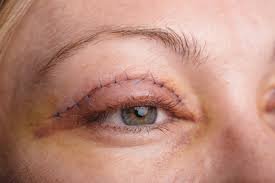NDP EyeCare | Dr. N D Patil | Dr. Gaurav Patil | Cataract | Glaucoma | Oculoplasty | LASIK
Our Latest Equipment is Best to keep your Vision perfect like Eagle!

Eyelid Surgery in Nagpur – Dr. N D Patil
Who is a good candidate?
Eyelid surgery is suited for those who:
Have excess skin or fat in upper or lower eyelids, causing sagging or puffiness.
Experience drooping eyelids that may interfere with peripheral vision.
Wish to reduce under‐eye bags or puffiness for a more youthful, rested appearance.
Are generally healthy and non‐smokers, or willing to stop smoking before surgery.
Have realistic expectations about what surgery can achieve.
Before undergoing the procedure, patients should have a thorough consultation. The surgeon will examine eye health, skin type, eyelid anatomy, general health, and discuss patient goals.
What does eyelid surgery (blepharoplasty) involve?
Types of blepharoplasty:
Upper eyelid surgery — removes sagging skin/fat above the eye.
Lower eyelid surgery — addresses under‐eye bags and excess lower eyelid skin.
Combined upper + lower eyelid surgery for overall rejuvenation.
Procedure:
Incisions are usually made in the natural crease of the upper lids or just below the lower lash line (or sometimes the interior inside the lower lid) to hide scars. Excess skin and fat are removed or repositioned. In some cases, muscle or underlying structure is adjusted. The aim is both aesthetic improvement and preserving/ restoring function (e.g. opening field of vision).Anesthesia & Duration:
The surgery is commonly performed under local anesthesia with sedation, though in more complex cases general anesthesia may be used. The operation time can vary depending on how many eyelids are being treated, whether it’s upper, lower, or both.
Benefits of eyelid surgery
- Enhanced, refreshed, and more alert appearance. Sagging lids or under‐eye bags often make people look tired or aged; surgery helps restore a youthful look.
- Improved vision: In cases where drooping upper eyelids block one’s field of vision, surgery can help restore peripheral vision.
- Better comfort: Reduces heaviness in eyelids, excess folds, or puffiness that might cause irritation.
- Long‐lasting results: Though aging continues, blepharoplasty effects last for many years.
Risks & considerations
- Like all surgeries, there are risks of bleeding, infection, and reaction to anesthesia.
Swelling, bruising, and temporary discomfort are common postoperatively.
Possible temporary dryness of eyes, irritation, or double/blurred vision immediately after surgery.
Scarring: Usually minimal and concealed, but healing depends on individual skin type.
Asymmetry: Small differences may occur between the two eyelids; revisions might be needed in rare cases.
Why surgeon choice matters – what to look for
While I could not find reliable public sources confirming that Dr. N D Patil treats eyelid surgery or has special expertise in ophthalmic/cosmetic eye‐procedures, here are key traits to look for in a surgeon, especially in Nagpur:
Proper qualification in plastic surgery or oculoplastic surgery (not orthopedics). The technical demands for eyelid surgery are very specific.
Significant experience and a portfolio of before/after images.
Good hospital or clinic facility, with modern equipment and operating theatre standards.
Clear communication: detailed consultation about expectations, risks, recovery.
Postoperative support for care, dressings, follow‐ups.
If you are considering Dr. N D Patil , ensure his credentials align with the required specialisation in eyelid / facial plastic / oculoplastic surgery.
Eyelid surgery in Nagpur – what to expect
Initial consultation – evaluation of eyelids, general health, discussion of expectations.
Preoperative tests – perhaps eye health check, blood tests, etc.
Surgery day – usually outpatient or short hospital stay.
Recovery period – first week more intensive care; visible swelling/bruising reduce over 1-2 weeks.
Follow-ups – monitoring healing, managing any complications, assessing satisfaction.
Recovery & aftercare
Immediately after surgery: swelling, bruising, discomfort. Cooling/ice packs help.
Typically, sutures removed after about 5-7 days (depending on technique).
Avoid strenuous activity, heavy lifting, bending for at least a week or as directed.
Protect eyelids from sun / dust; use sunglasses, wear hats.
Apply prescribed eye drops/ointments as instructed.
Sleep with head elevated for a few days to minimize swelling.
Full healing and final appearance may take several weeks; scars fade over time.
Book an Appointment Today
If you are searching for the best glaucoma specialist in Nagpur, look no further than Dr. N.D. Patil at the Centre of Advanced Eye Care. Early intervention is the key to preserving your sight. So, don’t wait until it’s too late—schedule your consultation today and take the first step toward protecting your vision.

